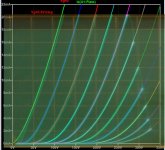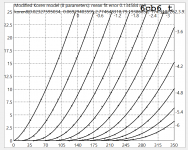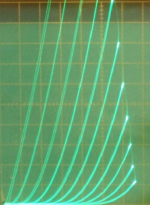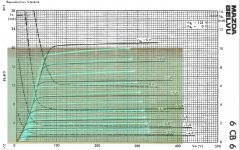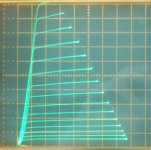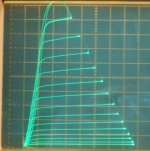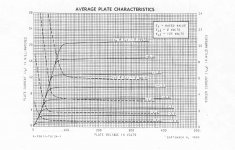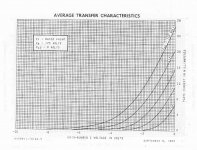I think your best bet would be to contact John Broskie directly. His email address is posted on his Tube CAD website (www.tubecad.com).
Thanks Ray, will do. I'm aware of the software limitations and have an old laptop running XP that I planned to use. Also, I saw a tutorial for getting these to run on newer 64 bit OS's.
The pin compatible 6EW6 (versus 6GU5) triode curves look a lot better:
Posted new P-P power amp design
Or 6CB6 in triode, or 6JC6 in triode too:
http://www.diyaudio.com/forums/tubes-valves/151206-posted-power-amp-design-151.html#post4628842
I seen you've done a thorough test on those tubes.
Do you the spice models for these tubes in triode strapped ?
Thanks a lot
I seen you've done a thorough test on those tubes.
Do you the spice models for these tubes in triode strapped ?
Thanks a lot
There are models already but if you like to use model based on these curve plot, here is 6c6_t:
* 6cb6_t LTSpice model
.subckt 6cb6_t P G K
+ params: ccg=6.5p cgp=0.015 ccp=3p rgi=1000
Bp P K I=(0.02327595034m)*uramp(V(P,K)*ln(1.0+(-0.06929403595)+exp((2.774648318)+(2.774648318)*((79.19386856)+(-174.3102262m)*V(G,K))*V(G,K)/sqrt((3.939429998e-006)**2+(V(P,K)-(-11.60203021))**2)))/(2.774648318))**(1.417585497)
rcp 1 3 1g
c1 2 3 {ccg}
c2 1 2 {cgp}
c3 1 3 {ccp}
r1 2 5 {rgi}
d3 6 3 dx
.model dx d(is=1n rs=1 cjo=1pf tt=1n).
.ends 6cb6_t
Attachments
@Koonw - for the 6CB6 and 6GU5 models that you posted above, did you check them against the datasheets (in pentode)? Just looking at the plate current quickly, their readings seem to be quite a ways off, i.e., the traced curves are somewhat suspect, which could be due to the tubes that smoking-amp used for the tracing or the scales given might be off.
6C41C SPICE Model
Your wish is my command...
Your wish is my command...
Code:
*
* Generic triode model: 6C41C_AN
* Copyright 2003--2008 by Ayumi Nakabayashi, All rights reserved.
* Version 3.10, Generated on Fri Sep 22 17:06:46 2017
* Anode
* | Grid
* | | Cathode
* | | |
.SUBCKT 6C41C_AN A G K
BGG GG 0 V=V(G,K)+0.99999997
BM1 M1 0 V=(0.34871634*(URAMP(V(A,K))+1e-10))**-1.9309325
BM2 M2 0 V=(0.43719892*(URAMP(V(GG)+URAMP(V(A,K))/1.6139223)+1e-10))**3.4309325
BP P 0 V=0.0056728375*(URAMP(V(GG)+URAMP(V(A,K))/3.6915056)+1e-10)**1.5
BIK IK 0 V=U(V(GG))*V(P)+(1-U(V(GG)))*0.009237979*V(M1)*V(M2)
BIG IG 0 V=0.0028364187*URAMP(V(G,K))**1.5*(URAMP(V(G,K))/(URAMP(V(A,K))+URAMP(V(G,K)))*1.2+0.4)
BIAK A K I=URAMP(V(IK,IG)-URAMP(V(IK,IG)-(0.0052912015*URAMP(V(A,K))**1.5)))+1e-10*V(A,K)
BIGK G K I=V(IG)
* CAPS
CGA G A 15p
CGK G K 7p
CAK A K 5p
.ENDS@Koonw - for the 6CB6 and 6GU5 models that you posted above, did you check them against the datasheets (in pentode)? Just looking at the plate current quickly, their readings seem to be quite a ways off, i.e., the traced curves are somewhat suspect, which could be due to the tubes that smoking-amp used for the tracing or the scales given might be off.
Don't find any original curve for 6gu5.
The smoking-amp's pentode curve for 6cb6 is compared to Mazda's, but they are plots for Vg2 equal to 130v and 125v, respectively and different Vg steps, still, it is not very far from original (see Vg=0). The triode model traced very well and tight, CurveTracer will not generate it, if it's just slightly out as tolerance is low, IHMO.
Attachments
I just re-checked the two RCA 6CB6A/6CF6 tubes I have here, and I get triode (g3 connected to cathode, g2 conn. to plate) Mu of 42 at around 5 mA and Mu of 45 around 12 mA. This is somewhat higher than the datasheet derived value of 36 Mu. Probably higher gm1 here than average spec. New tubes usually are above the average. Connecting g3 to g2 and plate lowers the Mu about 2%, so respective Mu about 41 and 44 then.
6CF6 seems to be identical to 6CB6A.
Some burn-in probably would lower the gm and Mu figures down to spec.
Edit: seeing the 6CB6 pentode trace (130 Vg2 and -0.3Vg1 steps) over the datasheet curves (125Vg2) would indicate that the grid2 gm2 is not quite as high for the RCA tubes, so that would explain some of the higher Mu factors seen here.
6CF6 seems to be identical to 6CB6A.
Some burn-in probably would lower the gm and Mu figures down to spec.
Edit: seeing the 6CB6 pentode trace (130 Vg2 and -0.3Vg1 steps) over the datasheet curves (125Vg2) would indicate that the grid2 gm2 is not quite as high for the RCA tubes, so that would explain some of the higher Mu factors seen here.
Last edited:
@smoking-amp & Koonw - ok, I generated a pentode model for the 6CB6 using the traced triode curves, and here is the resultant characteristic compared to the datasheet, as you can see, the cuves are far from close, even if we factor in the tube tolerance and the error that was introduced by the methodology used...
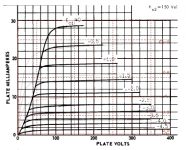

I just re-checked the two RCA 6CB6A/6CF6 tubes I have here <snip>
I'm sorry to bother you again, true the model traced by CurveCaptor shows that 6cb6 triode mode has a gain of 36, while existing Asymi model is 23. I use Paint tool model gain is near 20. There is no way I can achieve a gain of 36 using your pentode or original pentode curve. There are other triode plots on the net such as 6f12p, I can manage to find a close fit, but not this one. So could it your triode plot is wrong scale or missed named (not belong 6cb6), please advise again.
Last edited:
6SF5 SPICE Model
Code:
*
* Generic triode model: 6SF5_AN
* Copyright 2003--2008 by Ayumi Nakabayashi, All rights reserved.
* Version 3.10, Generated on Sat Dec 13 18:55:08 2014
* Plate
* | Grid
* | | Cathode
* | | |
.SUBCKT 6SF5_AN A G K
BGG GG 0 V=V(G,K)+0.99999997
BM1 M1 0 V=(0.031634481*(URAMP(V(A,K))+1e-10))**-0.46975888
BM2 M2 0 V=(0.76151452*(URAMP(V(GG)+URAMP(V(A,K))/7.5387827)+1e-10))**1.9697589
BP P 0 V=0.00039029593*(URAMP(V(GG)+URAMP(V(A,K))/9.8997228)+1e-10)**1.5
BIK IK 0 V=U(V(GG))*V(P)+(1-U(V(GG)))*0.00022622154*V(M1)*V(M2)
BIG IG 0 V=0.00019514796*URAMP(V(G,K))**1.5*(URAMP(V(G,K))/(URAMP(V(A,K))+URAMP(V(G,K)))*1.2+0.4)
BIAK A K I=URAMP(V(IK,IG)-URAMP(V(IK,IG)-(0.00025575454*URAMP(V(A,K))**1.5)))+1e-10*V(A,K)
BIGK G K I=V(IG)
* CAPS
CGA G A 2.4p
CGK G K 4p
CAK A K 3.6p
.ENDSHere are pentode mode curve traces for the two NOS RCA 6CB6A/6CF6 tubes I have.
Vert. Scale is 2 mA/div and Horiz. scale is 50V/div
Grid 1 steps are 0.25V
Both were adjusted to get a similar graph to the GE datasheet (except 0.25V steps here instead of 0.5V steps there). 1st tube needed 135V on grid2, and the second tube needed 120V on grid2. (typical variation)
From the 2nd GE datasheet plate/grid1 curves one can easily compute the triode Mu as around 36 for a nominal tube. (including the plate 280,000 Ohm Rp effect would drop that Mu by 1.6% to 35.4)
If one takes into account the 135 Vg2 required on the 1st tube to get the same pentode curve results as the datasheet at 125 Vg2, then that tube Mu would be increased to 135/125 x 36 = 39 (I think I got around Mu 42 earlier, but that depends on what current level Mu gets measured at)
There is clearly some grid1 gm difference between the two RCA tubes as well. About 13% more gm1 for tube 2. Which would increase its Mu factor by 1.13. But the lower 120V Vg2 would lower its Mu by about 120/125. Giving: 36 x 1.13 x 120/125 = 39 expected Mu. Both tubes measured similar triode Mu's, now we know why. (probably just more cathode emission in tube 2, Mu is determined by the grid geometries and should be more constant for similar tubes)
Vert. Scale is 2 mA/div and Horiz. scale is 50V/div
Grid 1 steps are 0.25V
Both were adjusted to get a similar graph to the GE datasheet (except 0.25V steps here instead of 0.5V steps there). 1st tube needed 135V on grid2, and the second tube needed 120V on grid2. (typical variation)
From the 2nd GE datasheet plate/grid1 curves one can easily compute the triode Mu as around 36 for a nominal tube. (including the plate 280,000 Ohm Rp effect would drop that Mu by 1.6% to 35.4)
If one takes into account the 135 Vg2 required on the 1st tube to get the same pentode curve results as the datasheet at 125 Vg2, then that tube Mu would be increased to 135/125 x 36 = 39 (I think I got around Mu 42 earlier, but that depends on what current level Mu gets measured at)
There is clearly some grid1 gm difference between the two RCA tubes as well. About 13% more gm1 for tube 2. Which would increase its Mu factor by 1.13. But the lower 120V Vg2 would lower its Mu by about 120/125. Giving: 36 x 1.13 x 120/125 = 39 expected Mu. Both tubes measured similar triode Mu's, now we know why. (probably just more cathode emission in tube 2, Mu is determined by the grid geometries and should be more constant for similar tubes)
Attachments
Last edited:
6CB6 was registered by RCA in 1949
6CB6A was registered by GE in 1956
(appears to have the same datasheet curves)
From a production standpoint, grid winding forms eventually wear out, and then someone has to machine a new one. No CNC equipment back then to get it exactly the same. I'd guess the new RCA standard Mu for 6CB6A is 39 now.
6CB6A was registered by GE in 1956
(appears to have the same datasheet curves)
From a production standpoint, grid winding forms eventually wear out, and then someone has to machine a new one. No CNC equipment back then to get it exactly the same. I'd guess the new RCA standard Mu for 6CB6A is 39 now.
Last edited:
- Home
- Amplifiers
- Tubes / Valves
- Vacuum Tube SPICE Models
